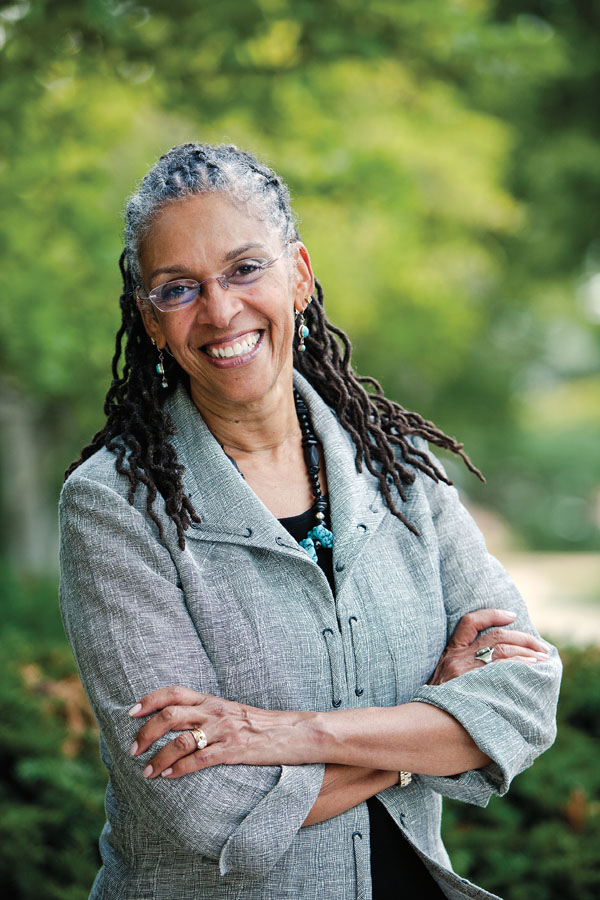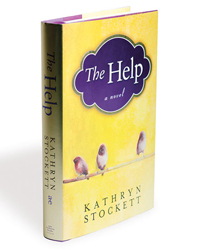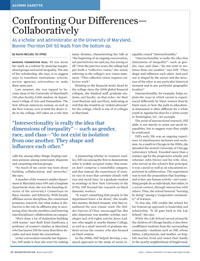Alumni Gazette
 ‘STATESWOMAN’: Dill has been praised for her research in women’s studies and as a campus ‘stateswoman’ at the University of Maryland, where she serves as a dean. (Photo: John T. Consoli/University of Maryland Publications)
‘STATESWOMAN’: Dill has been praised for her research in women’s studies and as a campus ‘stateswoman’ at the University of Maryland, where she serves as a dean. (Photo: John T. Consoli/University of Maryland Publications)Bonnie Thornton Dill ’65 has made her mark as a scholar by studying marginalized groups and social inequality. The aim of her scholarship, she says, is to suggest ways to transform institutions—schools, service agencies, universities—to make them more just.
Last summer, she was tapped to become dean of the University of Maryland’s 320-plus-faculty, 5,500-student, 14-department College of Arts and Humanities. The first African-American woman, as well as the first woman, ever to hold the dean’s title in the college, Dill takes on a role that calls for, among other things, forging common purpose among notoriously disparate and competing interest groups.
“So much of my career has been about building collaborations and networks,” she says.
A member of the women’s studies department at Maryland since 1991 and a longtime department chair, she was the founding director of the university’s Consortium on Race, Gender, and Ethnicity. With faculty affiliates across disciplines, the consortium promotes research, but what makes it distinctive is the role its affiliates play in mentoring other faculty members and fostering interdisciplinary collaborations on campus.
Dill on The Help
 (Photo: Adam Fenster)
(Photo: Adam Fenster)Given her scholarship on black women domestic workers, Dill says she’s often asked about The Help—both the novel, a 2009 bestseller by Kathryn Stockett, and the film, an adaptation of the book that came out last summer, and earned blockbuster status.
In her novel, Stockett, who is white and grew up in Jackson, Miss., with the help and companionship of a black maid, took on the voice of three fictional black maids in Jackson in 1962, during the high tide of the civil rights movement.
Admirers were moved by the book, while critics found Stockett’s portrayal of black household workers presumptuous and demeaning.
Similar reactions accompanied the release of the film, and while they often followed racial lines, they didn’t always, with white as well as African-American entertainers, journalists, and academics on both sides of the debate.
Following the release of the film, the Association of Black Women Historians took the unusual step of issuing a formal statement. Both the book and the film ignored or downplayed much of what historians know about the actual lives of black women domestic workers, the scholars charged, including widespread participation in civil rights activism without prompting from white civil rights heroes.
Nonetheless, the film earned a number of accolades, including Best Picture, at the 2012 NAACP Image Awards. Actresses Viola Davis and Octavia Spencer (who won an Oscar for Best Supporting Actress for her portrayal of a maid in the film) have dismissed critics. In February, Spencer told commentator Tavis Smiley that Stockett “had the insight to write about women whom we’ve not heard from.”
That’s exactly the kind of assertion that concerns Dill. “It isn’t as if the story of black domestic workers, from their perspective, has not been told. It has been told multiple times and in multiple ways,” she says.
Dill, who read the book but did not see the film, added: “I thought the book a good read. But from my perspective, its most important revelations are about the white women who lived in Jackson, and about the ways propriety, form, appearances, and denial helped them ignore the real experiences of the people they lived with—white and black—on a daily basis.”
“That the lives, speech, manners, and experiences of the black women are not fully understood or well represented; that they are not placed in historical context; that they exist as if this is the first and only effort to understand the experience of black women private household workers in the South, is inexcusable.”
—Karen McCally
“She’s done a lot of institution building with teams,” says Ruth Enid Zambrana, a professor of women’s studies at Maryland who has known Dill for more than three decades and now leads the consortium.
In her convocation remarks last September, Dill made it clear she won’t be making many dictates, characterizing her talk as “the beginning of an ongoing conversation, not just between me and you, but among us all.” Over the past two years, the college had put forth a “collective vision,” she noted, referring to the college’s new vision statement. “This collective vision requires collective work.”
Pointing to the financial strain faced by the college since the 2008 global financial collapse, she thanked staff, graduate students, and faculty—in that order—for their contributions and sacrifices, indicating as well that she would be an “ardent advocate” for the college, which is one of 13 colleges at Maryland.
A pioneering scholar in women’s studies, Dill was among the first to demonstrate what is widely accepted today: that women don’t comprise a monolithic category, and that instead, the experiences of women vary in ways that correlate closely with race and social class. As a graduate student in sociology at New York University in the 1970s, Dill focused her research on black domestic workers.
“It wasn’t something that people in the department knew a lot about,” she recalls. Her mentor, Richard Sennett, who had coauthored the now-classic work The Hidden Injuries of Class, encouraged her. But also important was another scholar, sociologist and civil rights activist Joyce Ladner, who taught at nearby Hunter College, as well as a small network of graduate students across the country who also focused on black women.
In the 1980s, Dill helped develop a nuanced approach to the study of social inequality coined “intersectionality.”
“Intersectionality is really the idea that dimensions of inequality”—such as gender, race, and class—“do not exist in isolation from one another,” says Dill. “They shape and influence each other. And each one is shaped by the nature and the structure of the other at any particular historical moment and in any particular geographic location.”
Intersectionality, for example, helps explain the ways in which racism is experienced differently by black women than by black men; or how the path to educational attainment is often different for a white youth in Appalachia than for a white youth in Washington, D.C., for example. The point of intersectional research, Dill adds, is not merely to point out social inequalities, but to suggest ways they might be eradicated.
Dill’s early life was an ongoing experience of simultaneous inclusion and exclusion. As a youth in Chicago in the 1950s, she attended the storied University of Chicago Laboratory School. Founded more than a century ago by the progressive scholar and reformer John Dewey and his wife, Alice, who served as the school’s first principal, it was a social as well as an educational experiment in collaboration. The experiment was to test the proposition that learning—and in fact, any human activity—isn’t something people do as individuals, but rather, in a social context, through interaction with others. Thus, the school fostered “learning by doing” among a “cooperative community” of learners.
To this day, Dill credits the school for her bottom-up approach to leadership and scholarship. “It all goes back to the Lab School,” she says.
While the Lab School served primarily the children of Chicago faculty, it also drew unaffiliated students from the surrounding community—students such as Dill, whose father, a pharmacist, and mother, an English teacher, lived and raised their family in the nearby neighborhood of Englewood, then a working- and middle-class stronghold on the city’s South Side. Thus, says Dill, “I lived in two worlds—a white intellectual world and a black social world.”
At Rochester, where she enrolled in the fall of 1961, she was among the first African Americans ever to live in River Campus residence halls.
“She’s been first at a lot of things,” says Tina Scott ’65, Dill’s freshman roommate and lifelong friend. A native of Long Island, Scott, who is white, recalls a letter she received from the University along with her roommate assignment.
“They sent me a letter asking my permission” to room with a black student, says Scott, a psychologist at a counseling and mental health center in Texarkana, Ark., marveling at the sweeping social change that’s taken place in her and Dill’s lifetimes. “She was amazingly resilient,” says Scott of Dill. “She made friends so easily.”
Dill’s time at Rochester coincided with the civil rights movement. She took part, organizing a University of Rochester chapter of Friends of the Student Nonviolent Coordinating Committee, an organization helping extend voting rights in the South.
Although she came to Rochester as a pre-med major, she decided to major in English, studied abroad in England, and by her senior year, was mulling over future plans that were always changing. “Every week I’d have a new plan,” she says, chuckling.
After graduation, she moved to New York City to work for the Office of Economic Opportunity, the federal agency in charge of the programs that encompassed President Lyndon Johnson’s War on Poverty. It was here, she says, where she first started thinking about the role that social class played in the relative fortunes of Americans.
Her research on domestic workers, completed in 1979 and published in 1994 as the book Across the Boundaries of Race and Class: An Exploration of Work and Family Among Black Female Domestic Servants, is considered groundbreaking. It was among the earliest academic studies of black female household labor to be based on interviews with workers themselves—a pattern followed by many scholars since.
In leadership as well as scholarship, Dill takes an inclusive approach, bringing in voices that aren’t always heard.
“She has these wonderful interpersonal skills to make people feel that they’re cared for, and that they’re listened to,” says Zambrana. “It stands out. Few administrators really have it.”

